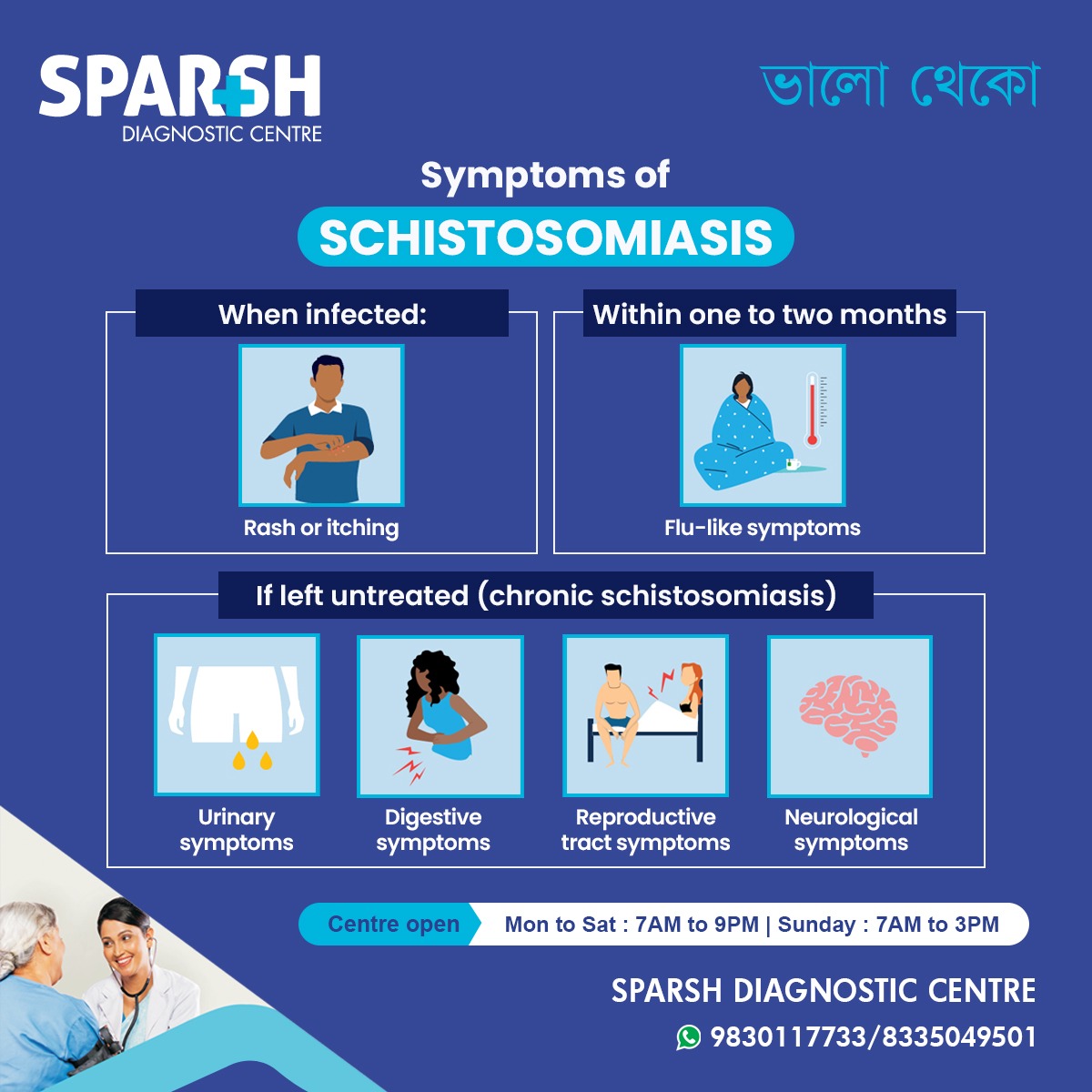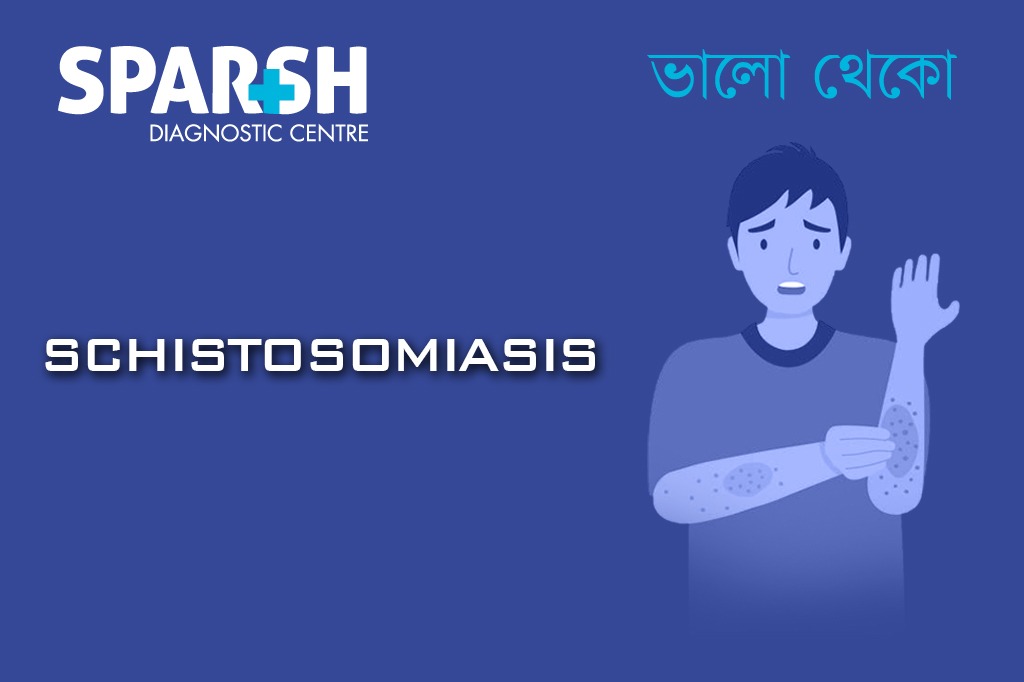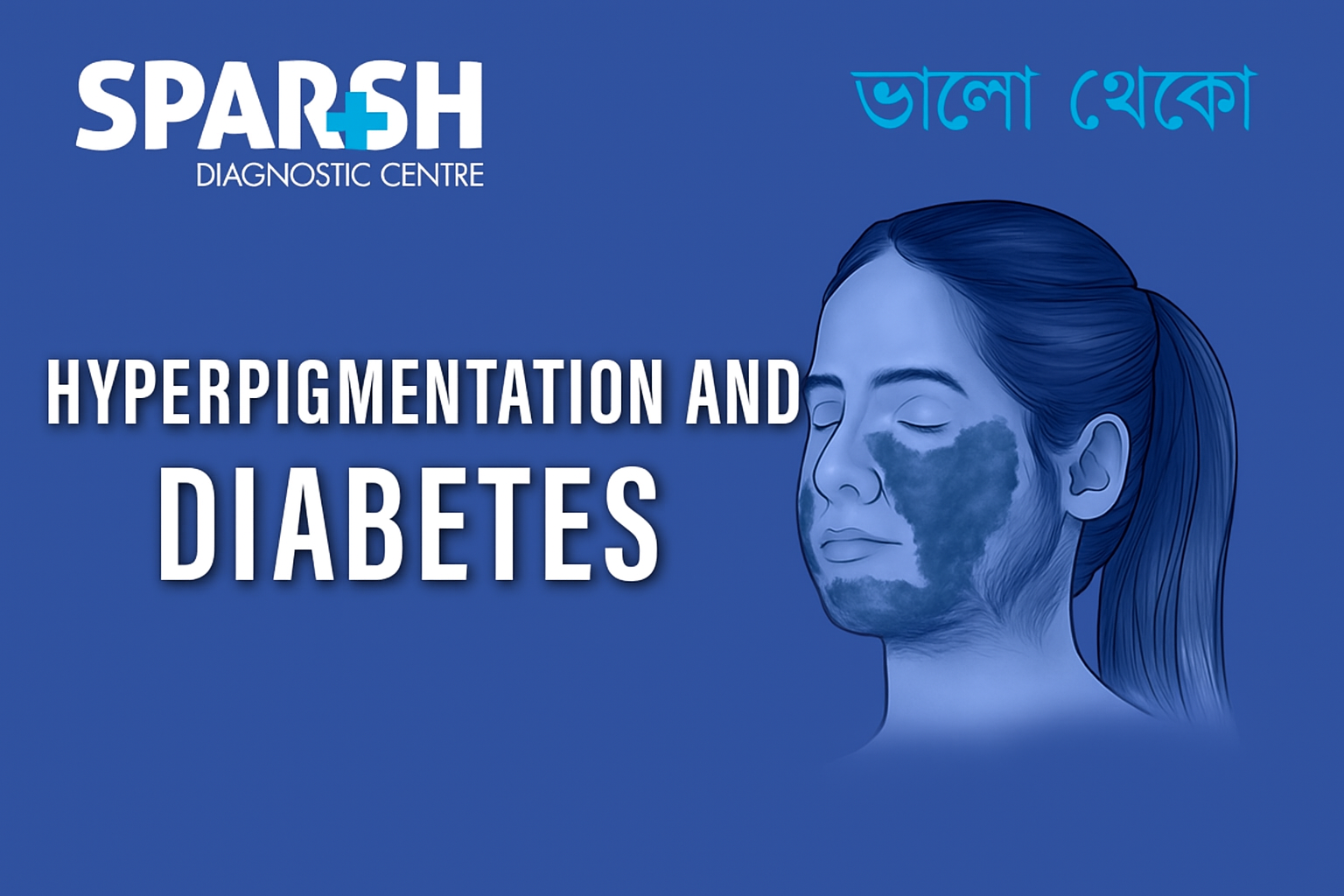Schistosomiasis, also known as bilharzia, is a parasitic disease caused by blood flukes of the genus Schistosoma. It is one of the most widespread neglected tropical diseases (NTDs), especially in areas with poor sanitation and limited access to clean water. According to the World Health Organization (WHO), estimates show that at least 251.4 million people required preventive treatment for schistosomiasis in 2021, out of which more than 75.3 million people were reported to have been treated.
Although preventable and treatable, schistosomiasis can lead to severe complications if left untreated, including chronic damage to the urinary tract, digestive system, reproductive organs, and even the nervous system. At Sparsh Diagnostic Centre, we emphasize early detection and timely treatment to prevent long-term health consequences.
This comprehensive guide will walk you through the causes, transmission, symptoms, diagnosis, treatment, and prevention of schistosomiasis.
What is Schistosomiasis?
Schistosomiasis is caused by infection with Schistosoma parasites. Unlike many other parasitic infections that spread through food, schistosomiasis spreads when people come into contact with freshwater contaminated with the parasites’ larvae. These larvae are released into the water by freshwater snails, which act as intermediate hosts.
Once the parasite enters the human body, it matures into adult worms and lives in the blood vessels. Female worms release eggs, some of which leave the body through urine or stool. However, many eggs remain trapped in tissues, causing inflammation, scarring, and organ damage over time.
Causes and Transmission
The life cycle of schistosomiasis involves both humans and snails:
Egg release: Infected individuals release Schistosoma eggs through urine or feces into water sources.
Hatching: The eggs hatch into larvae (miracidia) that infect freshwater snails.
Development in snails: Inside the snail, the parasite multiplies and develops into another larval form called cercariae.
Human infection: Cercariae are released into the water and penetrate the skin of humans who swim, bathe, or work in contaminated water.
Maturation: The larvae migrate through the body, develop into adult worms, and settle in the veins near the bladder or intestines.
This cycle continues, leading to persistent transmission in endemic regions.
Symptoms of Schistosomiasis
The symptoms vary depending on the stage of infection:
1. Early Stage (when infected):
Rash or itching at the site of parasite entry (commonly called swimmer’s itch).
2. Acute Stage (within 1–2 months):
Chills
Cough
This is sometimes referred to as Katayama fever.
3. Chronic Schistosomiasis (if left untreated):
Over time, the body’s immune system reacts to the parasite eggs trapped in tissues, leading to organ damage. Symptoms include:
Urinary symptoms: Blood in urine, pain during urination, increased risk of bladder cancer.
Digestive symptoms: Abdominal pain, diarrhea, bloody stools, liver enlargement, and fibrosis.
Reproductive tract symptoms: Infertility, pelvic pain, increased risk of HIV infection in women.
Neurological symptoms: Seizures, paralysis, or spinal cord inflammation if eggs migrate to the brain or spinal cord.

Complications of Schistosomiasis
If schistosomiasis remains untreated for a long time, it can cause serious complications, such as:
Chronic liver disease (hepatic fibrosis, cirrhosis, portal hypertension).
Kidney damage and bladder cancer.
Infertility and complications during pregnancy.
Neurological impairment (paralysis, seizures).
Stunted growth and learning difficulties in children due to chronic infection.
Diagnosis of Schistosomiasis
Early diagnosis plays a crucial role in preventing long-term damage. At Sparsh Diagnostic Centre, our specialists recommend:
Stool and urine tests: Microscopic examination to detect parasite eggs.
Blood tests (serology): Detect antibodies or antigens related to the parasite.
Ultrasound scans: To assess organ damage in chronic cases.
PCR and advanced molecular tests: Highly sensitive methods for detecting infections.
Treatment of Schistosomiasis
The primary treatment for schistosomiasis is Praziquantel, an antiparasitic medication that kills adult worms. It is safe, effective, and widely used in endemic regions.
Key points about treatment:
A single dose is often sufficient but may need to be repeated.
It does not prevent reinfection, so preventive measures are crucial.
In chronic cases, supportive treatments (e.g., for liver fibrosis or urinary tract complications) may also be required.
Prevention of Schistosomiasis
Since reinfection is common, prevention is as important as treatment. Effective preventive measures include:
Avoid contaminated water: Do not swim, bathe, or wash clothes in freshwater bodies in endemic areas.
Improve sanitation: Prevent contamination of lakes and rivers with human waste.
Snail control programs: Reduce snail populations in high-risk water bodies.
Mass drug administration (MDA): In highly endemic areas, periodic distribution of praziquantel to entire communities reduces infection rates.
Health education: Awareness campaigns to inform people about risks and prevention.
Schistosomiasis in India
Though more prevalent in Africa, schistosomiasis has also been reported in parts of India, particularly in rural communities with poor sanitation. Public health authorities continue to monitor and implement control measures in endemic zones.
Why Early Detection Matters
At Sparsh Diagnostic Centre, we stress the importance of early detection:
Prevents irreversible damage to the liver, kidneys, and reproductive organs.
Reduces transmission in the community.
Improves overall quality of life.
Our state-of-the-art diagnostic tools and expert doctors ensure timely diagnosis and effective treatment for parasitic diseases like schistosomiasis.
Frequently Asked Questions (FAQs)
1. What is schistosomiasis?
Schistosomiasis is a parasitic disease caused by blood flukes of the genus Schistosoma. It spreads through contact with contaminated freshwater.
2. How do people get infected?
Infection occurs when larval parasites penetrate the skin while swimming, bathing, or working in contaminated water.
3. What are the early symptoms of schistosomiasis?
The first symptoms include rash, itching, fever, chills, and muscle aches.
4. Can schistosomiasis cause cancer?
Yes, chronic schistosomiasis, particularly urinary schistosomiasis, can increase the risk of bladder cancer.
5. How is schistosomiasis diagnosed?
It is diagnosed through stool or urine examination, blood tests, and imaging studies like ultrasound.
6. Is schistosomiasis treatable?
Yes, praziquantel is the primary medication used to treat schistosomiasis effectively.
7. Can children get schistosomiasis?
Yes, children in endemic regions are especially vulnerable due to frequent exposure to contaminated water.
8. How can schistosomiasis be prevented?
Avoiding contaminated water, improving sanitation, snail control, and regular preventive treatment in endemic areas help reduce the risk.
9. Is schistosomiasis contagious from person to person?
No, it is not spread through direct human-to-human contact. Transmission occurs only through contaminated water.
10. Where can I get tested for schistosomiasis?
You can visit Sparsh Diagnostic Centre, where advanced diagnostic tools and expert doctors are available for accurate detection and treatment.
Schistosomiasis remains a major global health concern, particularly in regions with limited access to clean water and sanitation. While it is treatable with safe and effective medications, early detection is the key to preventing severe complications such as organ damage and cancer.
At Sparsh Diagnostic Centre, we provide accurate diagnostic testing and comprehensive care for parasitic infections like schistosomiasis. If you experience any symptoms such as persistent rash, fever, urinary problems, or digestive discomfort, don’t delay — consult our specialists for timely evaluation and treatment.
👉 Book your appointment today at Sparsh Diagnostic Centre and take charge of your health.
#BhaloTheko
Disclaimer:
No content on this site, regardless of date, should ever be used as a substitute for direct medical advice from your doctor or other qualified clinician.

![]()





